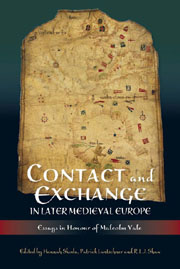Book contents
- Frontmatter
- Contents
- List of Illustrations
- List of Contributors
- Acknowledgements
- The Work of Malcolm Vale
- Principal Bibliography of Malcolm Vale
- Introduction
- Part I Boundaries and Units
- Part II Practices of Exchange
- Introduction
- In and Out of Africa: Iberian Courts and the Afro-Portuguese Olifant of the Late 1400s
- The Knowledge and Use of the ‘Teachings of Saint Louis’ in Fourteenth-Century England
- Philip of Chieti in Flanders, 1303–1305
- The Last Week of the Life of Edward the Black Prince
- Tournament Culture in the Low Countries and England
- Conclusions
- Index
- Tabula Gratulatoria
The Last Week of the Life of Edward the Black Prince
from Part II - Practices of Exchange
Published online by Cambridge University Press: 05 February 2013
- Frontmatter
- Contents
- List of Illustrations
- List of Contributors
- Acknowledgements
- The Work of Malcolm Vale
- Principal Bibliography of Malcolm Vale
- Introduction
- Part I Boundaries and Units
- Part II Practices of Exchange
- Introduction
- In and Out of Africa: Iberian Courts and the Afro-Portuguese Olifant of the Late 1400s
- The Knowledge and Use of the ‘Teachings of Saint Louis’ in Fourteenth-Century England
- Philip of Chieti in Flanders, 1303–1305
- The Last Week of the Life of Edward the Black Prince
- Tournament Culture in the Low Countries and England
- Conclusions
- Index
- Tabula Gratulatoria
Summary
Edward the Black Prince died in the palace of Westminster, after years of debilitating illness, on Trinity Sunday, 8 June 1376. There has been little or no discussion by historians of why the prince should have chosen Canterbury for burial, when Westminster abbey was already well-established as the royal mausoleum, or any discussion at all of another matter to which the prince gave attention in his very last days, namely the grant of a charter of disafforestation to the community of Wirral in his earldom and county of Chester. In order to recover the prince's own assessment of his life and significance at the end of his career, it is necessary to explore the reasons for both the charter and the burial in some detail.
To take the disafforestation of Wirral first, there are three documents that throw light on this. The charter itself is dated 20 July 1376, and was issued in the name of Edward III but on the orders of his son, the duke of Lancaster. The second is a reference to the disafforestation in the indictment roll of the session of the Chester county court held six months later, on 30 January 1377. The third is a petition of the community of Wirral to the king, asking for the charter to be confirmed by statute, a request that was never granted. The petition is undated, but must have been made between 20 July 1376 and Edward III's death on 21 June 1377, and almost certainly before 30 January 1377.
- Type
- Chapter
- Information
- Contact and Exchange in Later Medieval EuropeEssays in Honour of Malcolm Vale, pp. 221 - 246Publisher: Boydell & BrewerPrint publication year: 2012



